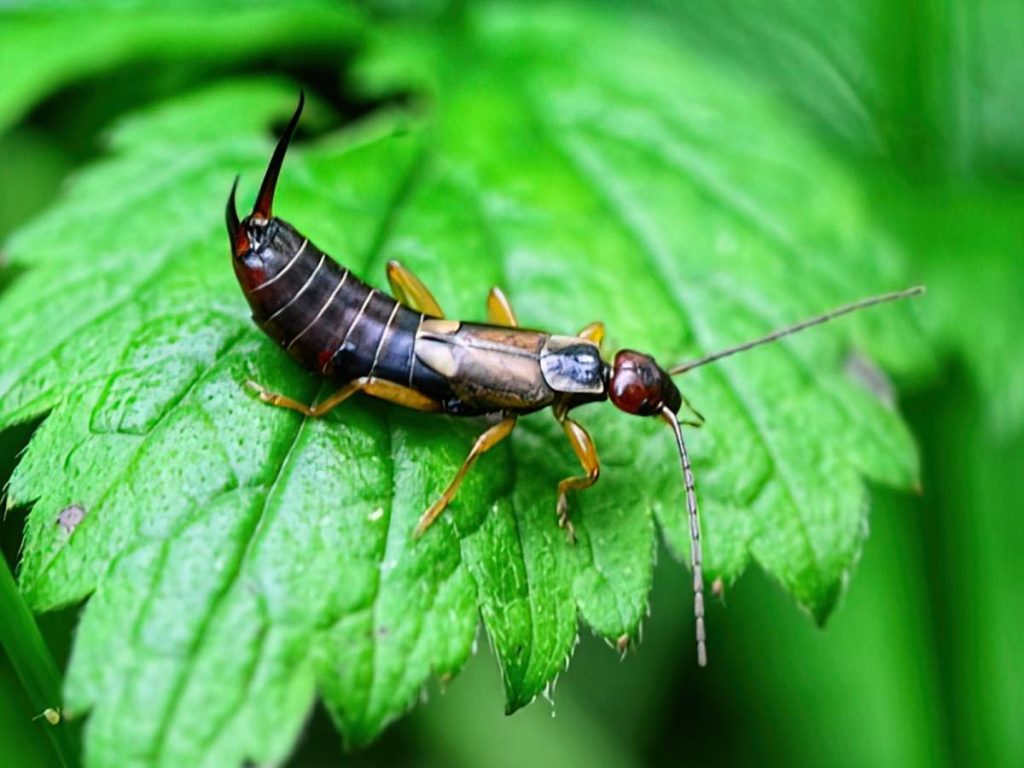Earwigs (also known as pincher bugs) are a pest that can be found in many gardens.
If your outdoor garden has been overrun with earwigs, it is easy for the problem to spiral out of control and affect other parts of the yard as well. If left untreated, this infestation will continue year after year without fail!
Here are some tips on how to keep earwigs from taking over your garden without using a toxic chemical.

Why Do I Have Earwigs in My Garden?
One possible reason why there are lots of earwigs in your garden is that they are attracted to gardens with a lot of plant debris and small insects.
Another reason is that earwigs don’t do well in climates that experience substantial changes in temperature, so they may try to come indoors during the colder or wetter months.
Additionally, earwigs are attracted to moist areas, including areas that are prone to water leakage, like your garden.
Finally, earwigs like a temperate climate that doesn’t experience large temperature changes, so they may try to come indoors during the colder or wetter months.
How to Identify Earwigs in the garden?
Earwigs are long, thin insects with a pair of pincers at the end of their bodies. They are dark brown or black in color and are active at night.
They are often found in dark, damp areas such as gardens, where they feed on plant matter and other insects.
Earwigs are attracted to light, so if you have a porch light on, you may see them in your garden.
How to Get Rid of Earwigs in the Garden Naturally? (16 Easy Ways)
1. Using a Vacuum Cleaner
To get rid of earwigs using a vacuum cleaner, first make sure that the vacuum bag or container of soapy water is clean and dry.
Next, turn on the vacuum cleaner and hold the end of the hose over the area where the earwigs are. Slowly move the hose around to suck up as many earwigs as possible.
Finally, dispose of the vacuum bag or container of soapy water in a sealed garbage bag to prevent them from escaping.
2. Using Diatomaceous Earth
Diatomaceous earth is an effective way to get rid of earwigs. The earwigs are attracted to the low moisture levels in the diatomaceous earth and they are killed when they come into contact with it.
Diatomaceous earth loses its effectiveness when it gets wet, so it is best used in dry climates.
3. Using a Mixture of Soap and Water
Earwigs can be eliminated by mixing soap and water together and spraying them.
The mixture will kill the earwigs on contact. To attract earwigs, place a bright light near where they are infesting and wait for them to gather around it. Then, carefully drown them in the soapy water mixture.
4. Using Essential Oils
You can get rid of earwigs by using essential oils. Soak cotton balls in a mixture of essential oil and water, and then place them where the earwigs are hiding. The scent of the essential oil will repel the earwigs.
You may need to replace the cotton balls every so often, but this method will keep the pests away indefinitely.
You can also mix 15 drops of essential oil with 4 ounces of water and spray it in areas where earwigs are present.
This DIY treatment can be used both indoors and outdoors.
5. Using Natural Predators
There are many ways to get rid of earwigs, but one of the most effective is to use their natural predators.
Different areas will have different predators that eat earwigs, so it is important to investigate where these predators are present before attempting to get rid of them yourself.
One way to attract predators is by luring them in with food. Earwigs are attracted to birdbaths, bird feeders, and yards with lots of bugs. This makes birds a great natural predator for earwigs. Birds can help you get rid of earwigs by eating them.
Other common predators of earwigs include amphibians, centipedes, spiders, predatory wasps, and tachinid flies.
Earwigs have no natural predators and their populations can grow rapidly, leading to problems such as pest infestations. Using natural predators is a great way to keep their population under control.
6. Using a Light Trap
A light trap is an easy and effective way to get rid of earwigs. All you need is a bowl of soapy water and a light source.
Earwigs are attracted to light, so they will crawl into the bowl after being exposed to the light. The soap will drown them and they will be eliminated.
7. Using a Tuna Trap
You can get rid of earwigs by using a tuna trap.
Place an empty tuna can containing soy sauce and vegetable oil at the base of each infected plant. As a result, any surrounding earwigs will be lured in, trapped, and eventually killed.
8. Using a Newspaper Trap
To make a newspaper trap to get rid of earwigs, you will need to wet some old newspapers and roll them up into a tube. Then, place the tube in an area where earwigs are known to congregate.
The earwigs will be attracted to the moist paper and will crawl inside the tube to get shelter. The next day, you can dispose of the trap and the earwigs by soaking the paper in soapy water and then rolling it up.
9. Using Baking Soda Spray
To get rid of earwigs naturally, you can use a baking soda spray.
Add a couple tablespoons of baking soda to a spray bottle filled with water and add soap. Then, add baking soda to soapy water and pour it down the drain to stop earwigs from coming up.
10. Using Oil and Soy Sauce as Traps
To make an earwig trap, mix equal parts soy sauce and vegetable oil and put it in a container. Earwigs are attracted to the smell of soy sauce and will enter the trap, but won’t be able to get out because of the oil.
11. Using Sticky Traps
Earwigs can be a nuisance to trees, and some solutions include using sticky traps or duct tape. Earwig traps are also available online. To make your own earwig trap, you will need:
– A small container
– Some petroleum jelly
– A piece of cardboard
– Scissors
Instructions:
1. Cut a small hole in the center of the cardboard, and then cut a slit from the edge of the cardboard to the hole. This will form a funnel.
2. Place the funnel into the container so that the hole is at the bottom.
3. Apply a generous amount of petroleum jelly to the inside of the funnel. The earwigs will be attracted to the jelly and crawl into the funnel, but they won’t be able to get back out again.
4. Check your trap daily and dispose of any earwigs you find inside it.
12. Using a Dry Barrier
There are a number of ways to get rid of earwigs naturally. One way is to simply add a small moat of sand or fine gravel around your garden. This will help prevent future infestations.
Another way is to make sure that you eliminate all damp, dark areas in your garden as much as possible.
13. Using Birds
If you have a problem with earwigs, you can use birds to get rid of them. All you need to do is provide the birds with a buffet of insects and they will take care of the rest.
You can attract birds to your yard by providing bird-friendly amenities such as bird baths and perching sticks.
Brightly colored decorations are also very popular with birds and can help attract them to your property.
14. Using Beer
Earwigs are attracted to beer. You can use this to your advantage by setting up a trap.
All you need is a shallow dish and some beer. Place the dish near areas where earwigs are a problem. The earwigs will be attracted to the beer and will crawl into the dish where they will drown.
15. Using Repellent Plants
Earwigs are attracted to lavender because of its strong scent. To get rid of earwigs, plant lavender around your garden or use essential oils. The earwigs will be repelled by the strong scent and unable to survive.
16. Using Organic Earwig Pesticide
Azera is an organic earwig pesticide that is safe to use on most plants. It is made with pyrethrins and azadirachtin, which makes it effective against earwigs. Azera breaks down in sunlight, making it environmentally friendly.
To make Azera, mix together:
– 1 part pyrethrin
– 1 part water
– 1 part neem oil
To use Azera, mix together:
– 1 tablespoon of dish soap
– 1 tablespoon of Azera mixture
Then add this to 1 gallon of water. Shake well and spray onto plants where earwigs are present.
Are There Any Natural Predators of Earwigs that You Can Encourage to Visit Your Property?
There are several natural predators of earwigs that you can encourage to visit your property in order to help control the population.
Some of the most effective predators of earwigs include tachinid flies, parasitic wasps, frogs, spiders, and centipedes. Toads and frogs will eat earwigs, and small reptiles like lizards will also prey on them. Birds are another natural predator of earwigs, and spiders and centipedes will also eat them.
What Other Natural Repellents Work Against Earwigs?
There are a few essential oils that can be used as natural repellents against earwigs. To create a repellent, mix 15 drops of an essential oil with 4 ounces of water. Add the repellent to a spray bottle and spray in areas where earwigs are hiding.
The scent of the essential oil will repel earwigs. Some oils that can be used include lavender, basil, peppermint, cinnamon, or clove.
What Natural Product Kills Earwigs?
If you’re looking for ways to get rid of earwigs naturally, there are a few things you can try.
One is to use diatomaceous earth, which is an all-natural product that can help get rid of these omnivorous insects.
Another is to plant certain plants that earwigs hate, such as plants that have certain oils or natural deterrents.
You can also try using a vacuum cleaner to vacuum up earwigs and put them in a jar, or using citrus oils to repel these pests.
What Scent Repels Earwigs?
Earwigs are susceptible to different scents that deter them. Many people are using scents to repel earwigs.
Scents have been heavily tested and proven to at least deter some pests. The most effective scents include: bitter, acetic, ethyl alcohol, citrus, fennel, geranium, rosemary, lavender, cedar, and pine.
What Can I Spray on Plants to Keep Earwigs Away?
There are a few things you can do to keep earwigs away from your plants.
One is to spritz them with a mixture of warm water and dishwashing liquid. This will kill any earwigs that are already on the plants, and deter others from coming.
Another option is to spray or wipe the leaves of your plants with a mixture of liquid dish soap and water. This will also help to keep earwigs away.
What Traps Can You Set for Earwigs?
Earwigs are often attracted to bright lights. An easy way to trap them is to place a bucket of soapy water underneath a light source. The earwigs will be drawn to the light and will fall into the bucket, where they will drown.
Traps can also be made from common household items, such as magazines or rolled up cardboard. To make a trap, simply roll up the material so that it forms a cylinder. Place the trap near areas where earwigs are likely to be found, such as in gardens or near potted plants. The earwigs will crawl into the cylinder in search of shelter and will be unable to escape.
Traps can also be made from oil or terracotta pots. Simply fill a pot with oil or water and place it near an area where earwigs are active. The earwigs will crawl into the pot and drown.
Does Neem Oil Kill Earwigs in the Garden?
Using neem oil to kill earwigs is commonly used by gardeners.
Instructions:
To kill earwigs with neem oil, mix water and pure organic liquid soap in a 1:1 ratio. You can also use Dawn dish soap for this recipe. Spray the soapy water solution on earwigs to kill them.
Then, apply neem oil to the circumference of the area where you want to kill the earwigs. Let the neem oil work its magic for a few days before checking the progress periodically to make sure the earwigs are dead.
What Do Earwigs Eat in the Garden?
Earwigs are attracted to decaying plant matter and will also eat seedlings and leaves. If you have earwigs in your garden, they can hinder plant growth by eating them.
What Deters Earwigs in the Garden?
Earwigs are attracted to dark, moist places. If you have earwigs in your garden, you can get rid of them by clearing away dead leaves and other yard detritus.
You can also spray the plants with a solution of water and dish soap, or coat the stems with petroleum jelly.
If you want a long-term solution, you can make your yard or garden more bird-friendly.
Will Vinegar Kill Earwigs?
Vinegar is a good option to kill earwigs as the earwigs will be repelled by the vinegar. However, it is important to use vinegar with a light hand so that you do not damage the plants.
You can mix vinegar with water (or straight vinegar) to create a repellent and then spray this around the garden and house. This will keep the earwigs away as they will not be able to enter the area.
Do Coffee Grounds Repel Earwigs?
If you’re looking for a natural way to repel earwigs, coffee grounds might be the answer. Although there’s no concrete evidence that coffee grounds repel earwigs, they may be worth a try.
Simply add a few tablespoons of coffee grounds to your garden or the area around your home. The earwigs will avoid the area, and you’ll be free from their pesky bites.
How to Stop Earwigs Eating Seedlings
There are a few different natural ways. One way is to clean them off your plants by spritzing them with a homemade mixture of warm water and dishwashing liquid. Another way is to make a trap out of a sugar and water solution, which will make the earwigs drunk and make them fall asleep in the trap.
Do Marigolds Repel Earwigs?
Earwigs are a common garden pest, and marigolds are a plant that repels them. The strong scent of marigolds is said to repel many pests, including earwigs. Many gardeners have grown marigolds as a preventative measure against pests and diseases.
Marigolds can be used as companion plants or made into pest-repellent concoctions.
Does Garlic Spray Deter Earwigs?
If you’re looking for a natural way to deter earwigs, garlic spray may be the answer. This method involves using a mix of garlics and water to create a spray that will repel earwigs.
To make the spray, you can make a more concentrated garlic spray by blending six cloves of garlic, 1 tablespoon of cayenne pepper, and 1 tablespoon of biodegradable dishwashing liquid in 1 quart of water. Let this mixture steep for 24 hours before straining the solids out and pouring the liquid into a spray bottle.
When using any kind of pesticide, it’s always important to test it on a small area first to make sure it won’t damage your plants.
So, before treating your entire garden with garlic spray, test it on one plant and wait 48 hours to see if there is any injury. If there isn’t, then you can go ahead and treat all your plants. Just be sure to apply the spray in the morning so it has time to dry before the evening.
Do Mothballs Repel Earwigs?
Mothballs are commonly used as an earwig repellent. However, exposure to gas from mothballs can lead to headaches, nausea, vomiting, diarrhea, eye and nose irritation, and coughing. Longer exposure times can lead to more severe effects like liver and kidney damage.
Follow all label directions and store pesticides safely, out from the reach of children and pets, to reduce exposure.
More Things to Know about Earwigs
What are Earwigs?
Earwigs (Pincher Bugs) belong to the insect order Dermaptera. There are about 2,000 different species of earwig found all over the world. The name “earwig” comes from the Old English word “ear-wicga,” which means “ear wiggler.” This refers to the earwig’s habit of crawling into people’s ears to lay its eggs! Thankfully, this is just a myth; earwigs do not burrow into human brains (or any other animal’s brains).
Earwigs are most commonly recognized for their menacing-looking cerci. Cerci are a pair of appendages that resemble pincers or forceps, and are used by earwigs to capture prey or defend themselves.
They are also quick movers, which can make them difficult to catch.
They are common in many parts of the United States. Earwigs can be found all over the world except Antarctica.
What Do Earwigs Look Like?
Earwigs are small, long, flat, reddish-brown insects with long antennae and pincers. Some earwigs have wings, and some do not. Earwigs use their pincers to defend themselves or to grab an enemy. The male earwig has curved pincers while the female has straight pincers.
What Do Earwigs Eat?
They feed on decaying vegetation, living plants, and pests. While they can have a negative impact on plant growth by eating seedlings, they can also have a positive impact by eating pest larvae or small animals.
How Long Do Earwigs Live for?
After mating, the female produces anywhere from 20 to 80 glossy, white eggs. The female will not lay eggs until she has expelled the male, which occurs in winter or early spring. The eggs of earwigs typically hatch in the spring, and their average lifespan is one year.
Where Do Earwigs Lay Their Eggs?
Earwigs lay their eggs in safe, hidden places. This is usually an underground chamber that the earwig has dug out for itself. The reason for this is that earwigs undergo incomplete metamorphosis through 4-6 molts. This means that the earwig larva looks very similar to the adult earwig, just smaller.
Earwigs also tend to drive out the males before they lay their eggs. This ensures that the male won’t mate with any other females and harm the development of the young.
Earwigs are unique in that they can lay their eggs in two different ways. They can either leave them as eggs, which will hatch later into earwig larvae, or they can lay them as live young.
Are Earwigs Dangerous?
Although earwigs provide no danger, if they become too numerous, they can become a nuisance. They can cause significant damage to your lawn and garden by eating leaves and other organic material.
To keep earwig populations under control, seal all cracks and crevices in the foundation and around the house, bury vegetable scraps and other organic material four to six inches deep, and remove any leaf litter or flowers from around plants.
If you suspect an infestation in your home, get rid of them as soon as possible.
Can Earwigs Bite?
Earwigs have a pair of pincers on their rear end that they use for defense when they feel threatened. Although earwigs can pinch humans, they do not inject any venom or poison, and the pinch usually causes minimal damage or harm.
Where Do Earwigs Go during the Day?
Earwigs are nocturnal insects that conceal themselves during the day and feed at night. They are attracted to dark, cool, moist places, and common hiding spots for them include under loose clods of soil, boards, or dense growth of vines or weeds.
Earwigs feed most actively at night, and they emit a foul odor when disturbed or squashed.
Do Earwigs Go Away in Winter?
Earwigs are insects that are active from May to November. They build nests in the fall to overwinter. During the colder season, earwigs will burrow into the ground to escape the cold weather.
The female earwig will build a nest for the pair to overwinter in. The nest is usually made from debris or other natural materials and is 2.5 cm below the soil surface.
What Diseases Do Earwigs Carry?
Earwigs are not known to carry or transmit diseases. However, they may pinch people when they feel threatened. The pinch from their pincers can cause minimal damage or harm. To prevent being bitten by an earwig, it is best to avoid handling them.
Are Earwigs Beneficial in the Garden?
Earwigs can be beneficial to your garden by consuming aphids and other small insects.
If they become destructive or infest your home, you can try using compost, predators, or traps to get rid of them.
If earwigs aren’t doing any harm, however, you may want to leave them be.
Are Earwigs Bad in the Garden?
While they don’t spread disease or harm people, their feeding habits can damage gardens. Earwigs can be a problem if you have a lot of these things in your garden.









